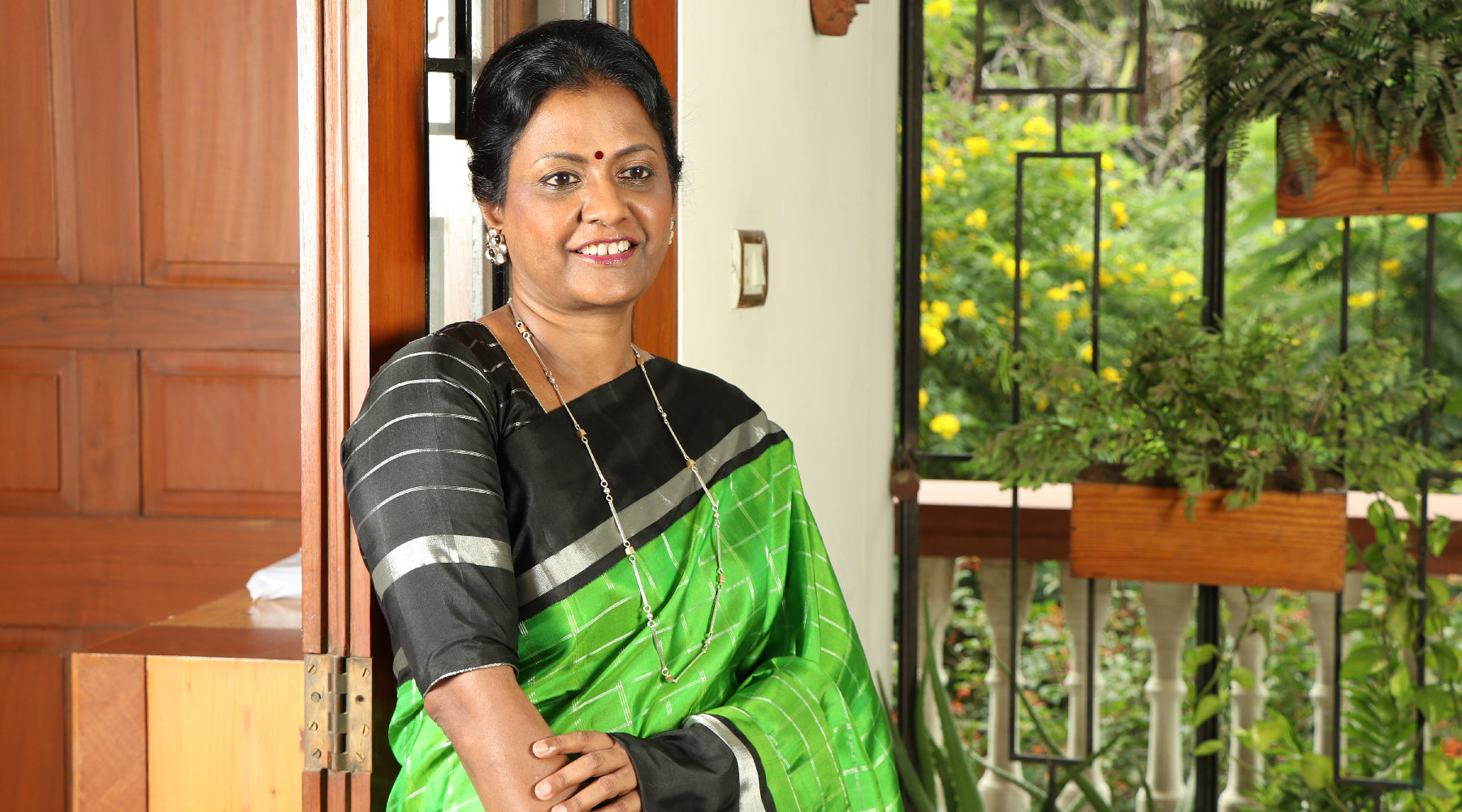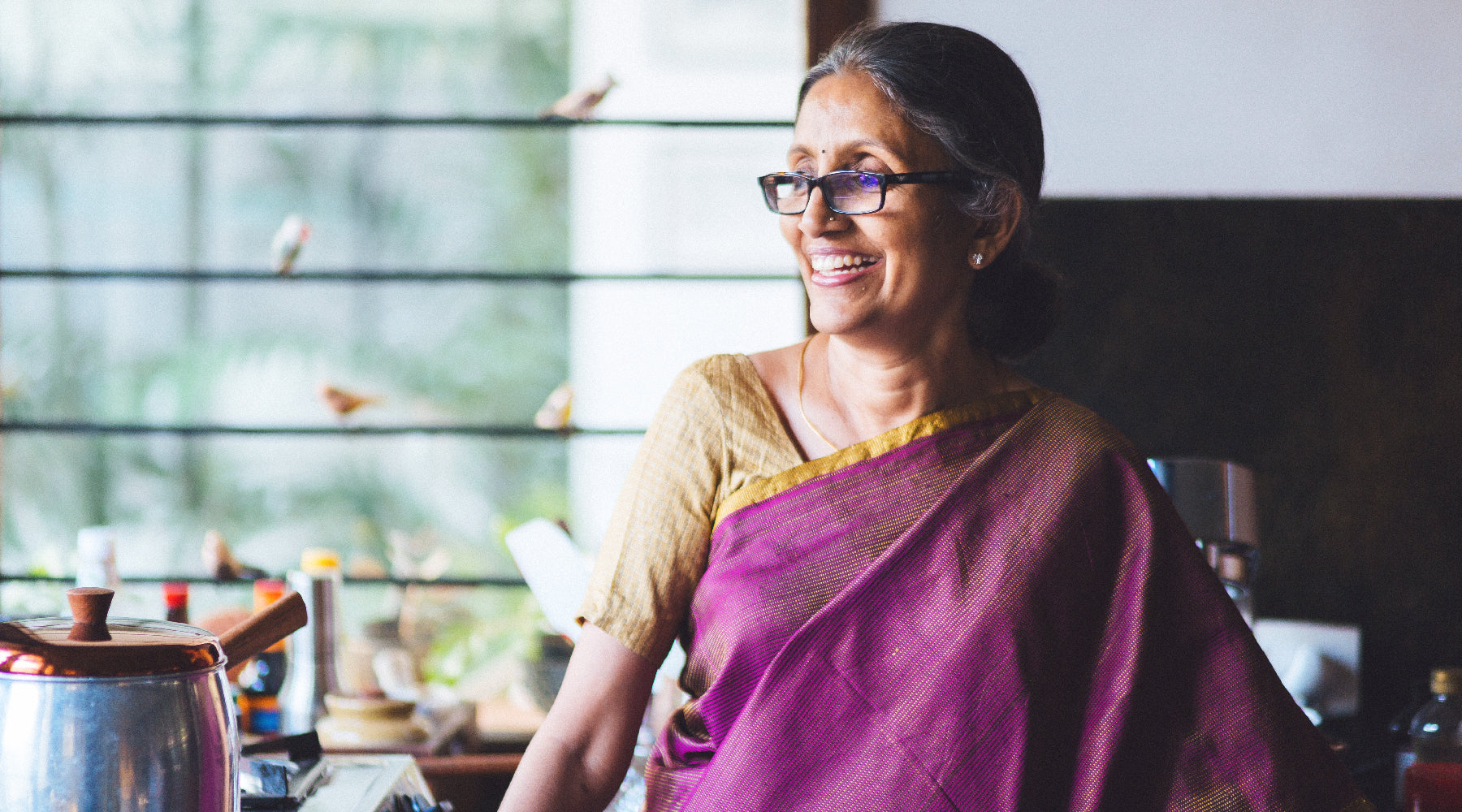KANAKAVALLI VIGNETTES : Sitara Vikram - Life & Learning

Dr. Sitara Vikram, co-founder and executive director of the CS Academy schools in Erode and Coimbatore, believes that you cannot go wrong with a kanjivaram. A trained psychiatrist with over 10 years of experience working in adult psychiatry in London, Sitara is deeply committed to her work in holistic education, drawing inspiration and wisdom from her background in medicine. On a quiet Sunday afternoon – her only day off – Sitara took time out of her busy schedule to speak with The Kanakavalli Journal and to curate a selection of drapes that appeal to her aesthetic and sense of identity. Candid and insightful, the conversation gives us a glimpse into Sitara’s experiences in forensic psychiatry, her values in education and in life, and her definitions of beauty. Excerpts below….
Life & Learning
You have done some incredibly interesting work as an adult and family psychiatrist in the UK. Could you tell us a little bit about that experience and how it shaped who you are today?
As a psychiatrist in the UK I worked in various fields, mostly dealing with adult psychiatry, of which forensics was one aspect. My job entailed working with mentally ill patients who had also committed offences – often quite serious ones – to assess whether their actions were a result of their condition. This required being present in court during trials and making a case for the patient; and if their mental illness was proved, they had to be shifted into forensic hospitals, many times against their will. Many of our patients were particularly difficult to treat, requiring strong medications, and recovery was a long-drawn and painful process. In most cases, they were unable to live in society again even after release, and would have to be monitored in hospital settings over the long term. It was an incredibly challenging and high stress job, and in a way, it is what led to my eventual return to India. I had also worked with families while in the UK, and I was struck by the contrast between the impact that psychiatry could have in the two fields. Despite the dedicated work of forensic psychiatrists, there was very little hope for many patients, who just did not seem to recover completely. However, while working with families, and especially with children, I was amazed at how small interventions could make a huge difference in the lives of the child and the parents. My experiences in the UK were invaluable, and the work I did there is a big part of who I am and what I do today. My background helps me deal with the emotional needs of the students, as well as to offer parenting advice to the community. As a psychiatrist, I am better equipped to deal with issues of depression and anxiety, and also to create basic therapeutic strategies that benefit the children. The awareness of mental and emotional health and needs is crucial, I think, in running a school.
How did you come to enter the field of education, and how does your training as a psychiatrist inform your work at CS Academy?
As a result of my experiences in the UK, I realised not only that I enjoyed working with children, but also that the most lasting impact can be made when a child is still young. Adults are very often too set in their ways or too scarred to truly experience the benefits that psychiatric care can offer. The kind of outcomes you get from working with young people, on the other hand, are so much more meaningful, shaping the child's entire personality and future. My background, I felt, would enable me to me cater to the needs of teacher, parent and children populations. And so, I returned to India. My in-laws have been running schools for 30 years in a small town in Tamil Nadu called Erode. My mother-in-law is a big inspiration and influenced me to take this work further by starting a school. We felt that there was so much more one could do in the field, and our dream was to ensure the children in our school had the same kind of exposure as city kids, and would go on to make an impact on society. We opened our first school in Erode with the vision of providing holistic education to children at a standard that was as high or higher than that of schools in the big cities. This was followed by the opening of our Coimbatore school. Over the years, the greatest joy and satisfaction has come from seeing the difference in the students after a time at our school. We notice how every little positive action makes a difference – improving students’ general level of happiness, their ability to cope. This is what makes the work we do so meaningful. I have always believed that counselling is a key aspect of education that is often overlooked in the Indian system, and we have a counselling department at CS Academy. In the UK, the community is far more accepting of issues of mental health, but here, too, things are changing and parents, teachers and others are realising the importance of emotional and psychological well-being.
How would you describe your personal values and beliefs about education? Did your own education inspire and influence you?
Having studied both in India and abroad, I always felt that the Indian system had a lot of good to offer, as well as aspects that needed more attention. We all learnt the value of perseverance, hard work, goal setting: it was a good tradition that helped us go abroad and succeed in our aspirations. I went on to study in London, and being a part of the educational system there showed me what Indian schools were lacking. Here, we don't stress the value of being a bold communicator and of independent thinking; we’re taught to repeat what we read and hear, and not to think on our own or express our opinions. I felt these areas and skills of opinion forming and presentation were absolutely important for students. What defines my values in education is blending what is good in our traditional system with skill sets required for the future – communication, presentation, thinking. Of course, knowledge is also extremely important, but the approach we have developed brings together the old and the new, forming an education system that is both knowledge- and skill-based. Apart from academics, the focus is on a truly holistic education; one that includes a range of co-curricular activities, such as art and music, performing arts, and sport. We encourage children to develop an all-round personality, and also to achieve excellence in any one area – for some this may be sport, for others, visual art. We help them find their uniqueness in a certain area, and we have a programme that enables that.
Can you tell us a little bit about how you developed an interest in yoga and homoeopathy, and the role these play in your personal and professional life?
When I finished medical school, there was a year or two when I decided to look into alternative medicine. I was doing psychiatry, and I thought that this was a field which you had to look at from different perspectives and alternate systems, like yoga and homoeopathy. I felt that these methods had something to offer to people who were depressed, or anxious, or stressed. So, I did a one-year teacher training course in Krishnamacharya Yoga Mandiram in Chennai, and I did a homeopathic programme in London. All these alternative approaches make you see mental health in a different way, a more holistic way. And they have helped me a great deal over the years, to offer people who are suffering from stress or anxiety something outside of just tablets and medication. Yoga is an extremely powerful tool in holistic wellness, and homoeopathy can also open up several possibilities for mental and emotional health. Personally, yoga is a very big part of who I am; I don't think I could manage my life without it. The Krishnamacharya Yoga Mandiram in Chennai where I did my course has been one of my greatest influences. For several years now I have spent an hour doing yoga every single day. It’s a breath-based practice, and I try to incorporate chanting, pranayama breathing exercises and meditation. It really helps in dealing with stress, and simply in reenergising me. It's the first thing I do when I come back from work every evening and it’s what keeps me going. Having seen the positive influence that yoga can bring in everyday life, we have implemented a yoga module at CS Academy as well. All our children take this programme when they enter grade 6, following which we introduce a weekly period devoted to yoga practice.

What does the sari, and the kanjivaram in particular, mean to you in your personal and professional life, and how do you define beauty?
The kanjivaram to me is a very classic, dignified piece of clothing. And what I love about Kanakavalli is how the brand blends that classic drape with a very modern and interesting touch. Even while curating the saris for the Vignettes, I was struck by the unusual shades, such as mint green or pastel blue, and the combinations of checks and stripes, of traditional weaves and contemporary hues. I like the blend of the old with the new, and how there’s such a nice, fresh touch to an ancient sari, making it so interesting that it adapts itself to varied occasions. You can't go wrong with a kanjivaram. When you go for a wedding, it is majestic and yet so ethnic. I don't really identify with some of the more modern shimmery drapes; I've always preferred a look that is classic. At work, for parent teacher meetings and other events, I find that the kanjivaram is the perfect option. When I want to look dressed up but dignified and grounded, it gives me just the right look. Beauty to me is very much defined by Ahalya’s aesthetic which I find exceptionally dignified and earthy. I think it is a combination of looking confident, feeling comfortable – it is a reflection of who you are. Personally, I like to look ‘Indian’, this makes me feel very comfortable. So, wearing my bindi, my lovely kanjivaram saris, and traditional jewellery; for me this is a very beautiful look because it appeals to who I am. I think beauty is what you identify with, what your self-expression is. And it varies from person to person.

What is the story behind the Kanakavalli kanjivaram you've chosen to wear for the shoot?
I was looking for a sari to wear for a reception and I wanted something in black, but not too black! While I was shopping, Ahalya was at the store, and she helped me pick this beautiful drape. It has hints of grey, blue and red, so although it’s black, it looks very vibrant with the colours and the threadwork. It’s a very old, heirloom weave that has been reinvented, and it perfectly matches my taste and aesthetic.

Sitara is wearing a classic kanjivaram from the Kanakavalli Vault. The weave, technique and motifs are absolutely traditional, but the palette of black, blue, red and white is unusual for the kanjivaram. The bold and striking colours lend the drape an elegant modern touch. The pallu is woven in the laborious 'adai' technique, entirely by hand, and the white seeru lines against the black of the border are particularly contemporary.
- Sitara Vikram, in conversation with Aneesha Bangera
Explore Sitara's Kanakavalli curation here



